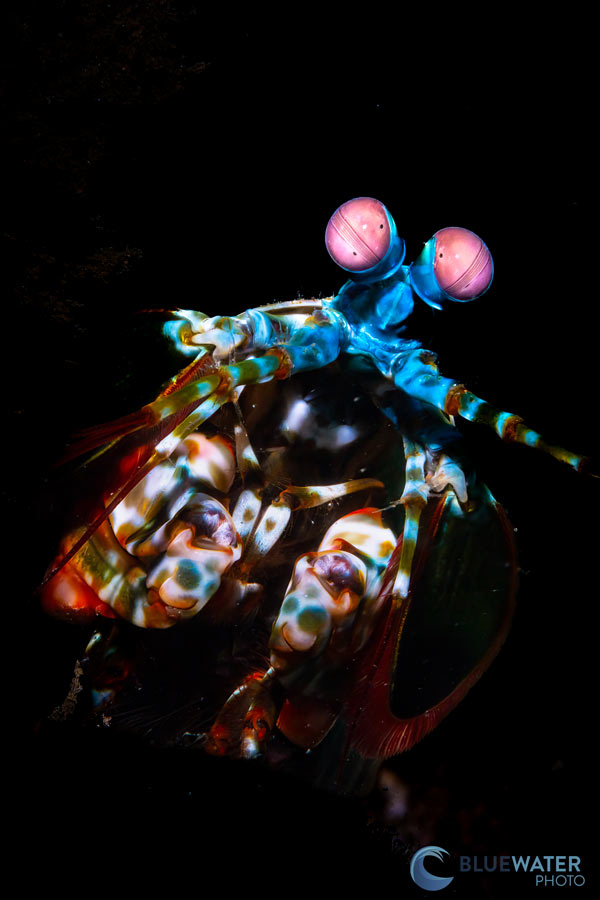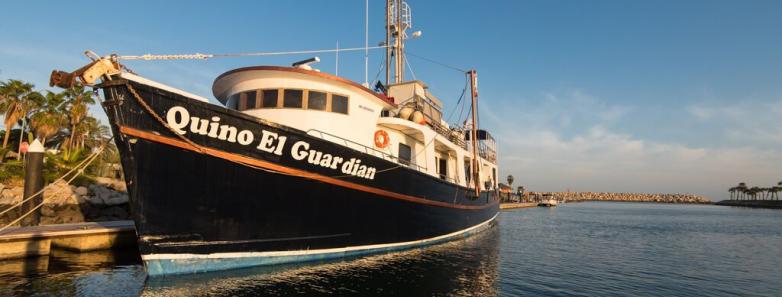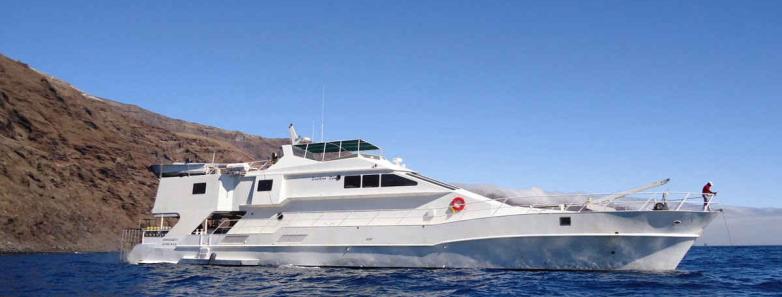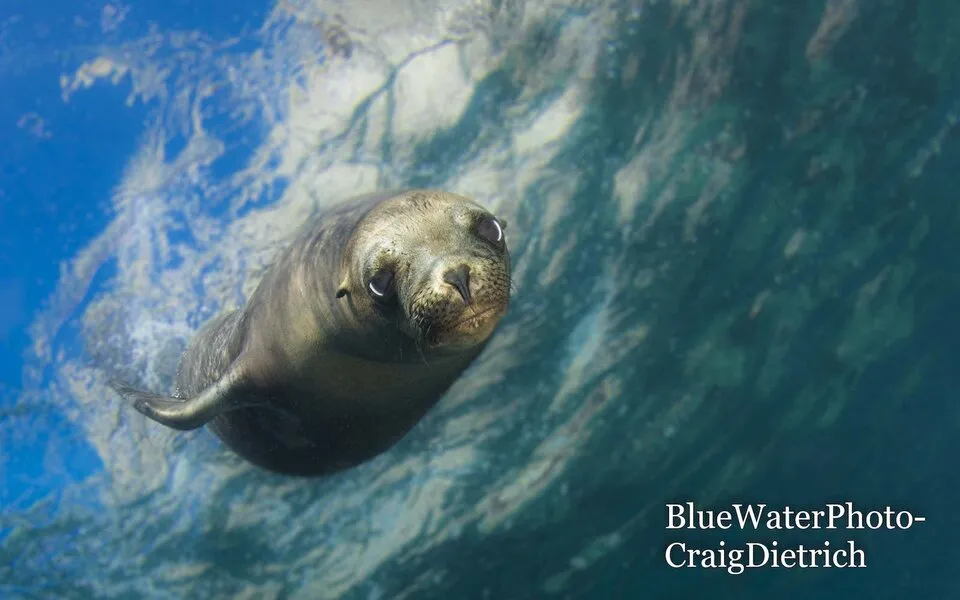Cabo San Lucas
Average flight time from LAX
3 hours
Scuba Dive Level
All Levels
Visibility
30 to 80 feet (9 to 24 meters)
80°F / 27°C
Average Water Temperature
Pelagic Encounters
Stunning Reefs & Corals
Scuba Diving In Cabo San Lucas, Mexico
Cabo San Lucas Diving Highlights
Within easy reach of the US and offering a diverse and exciting range of diving and snorkeling options, scuba diving Cabo San Lucas is not to be missed and is the perfect Mexican dive destination for families and friends alike. Forty miles to the east, diving Cabo Pulmo Marine Park offers a more remote alternative, with plentiful tropical species, an abundance of fish, and year-round resident bull shark population.
Cabo San Lucas Dive Resorts And Liveaboards
The diving in Cabo San Lucas and Cabo Pulmo is done from speedboats or pangas (small wooden boats). Many liveaboards depart from Cabo San Lucas and may stop to dive the area on their way into the Sea of Cortez. Cabo San Lucas is also the gateway to the Revillagigedo Islands, commonly known as the Socorro Islands.
Intro To Cabo San Lucas
Situated on the southern tip of the Baja California Peninsula, Cabo San Lucas offers a diverse range of tropical reef and pelagic diving where the Sea of Cortez meets the Pacific Ocean. On the regions southernmost point, the sheltered San Lucas Bay provides ideal novice diving conditions amongst rocky reefs and corridors, while the offshore walls and plateaus of Gordo Banks attract oceanic pelagics on migration into the Sea of Cortez . Cabo San Lucas offers something for everyone, and the lively resort makes it a great holiday destination.For divers looking for a quieter alternative, Cabo Pulmo Protected National Marine Park covers 27 square miles of the northernmost hard-coral reef in North America. Frailes Rock in the south of the park is home to a lively sea lion rookery, and the shallow waters of the park allow great access to explore the fascinating macro and tropical fish of the inshore reefs.
When To Go
The best time to dive in Cabo San Lucas is July to December. It is a year-round destination, however the summer months of June to August tend to get really hot. The best time for a visit is from December through April if you do not take scuba diving into consideration. The weather is pleasant, and you are avoiding the hurricane season from May through November.
Learn about Bluewater's 2-Day Marine Life Safari in Cabo and the Sea of Cortez.
Cabo San Lucas Diving Information
Marine Life & Photography Subjects
While it may not boast the world-class diversity found in the Sea of Cortez, a broad range of marine species can be found in the waters around Cabo San Lucas and Cabo Pulmo. Inshore sites such as Santa Maria and Chileno Bay are great places to discover nudibranchs, crustaceans, and other critters sheltering under rocky reefs and amongst unique rock formations. Keen eyes will be rewarded with sightings of the quirky calico lizardfish, loosetooth parrotfish, or spotted boxfish. Also, in Santa Maria Bay, large schools of Cortez rays can sometimes be spotted in the shallow water, and lucky divers may encounter a banded guitarfish.
A highlight of any trip to Cabo San Lucas and Cabo Pulmo is diving or snorkeling with the local sea lion colonies. These inquisitive creatures make a regular appearance at many of the areas dive sites and never fail to amuse and entertain with their mischievous antics.
Approximately 8 miles offshore at Cabo San Lucas, Gordo Banks is an exposed seamount and submerged plateau that attracts large ocean-going pelagics around its steep walls. Migrating humpback and gray whales can be spotted here between December and May, and this is also the best time to encounter schooling hammerhead sharks. Other regular visitors include tuna, turtles, and a variety of rays such as mobula and devil rays.
Through the winter months, humpback, gray, and sperm whales can also be spotted around El Bajo seamount (not to be confused with El Bajo at La Paz), where bait-balls of schooling jack offer a tasty pit-stop for these migrating giants. Other open ocean visitors include mobula rays, hammerhead sharks, and the occasional whale shark.
Typical Dive in Cabo San Lucas
Inshore dives take place from speed boats and, in some cases, traditional wooden pangas used by fishermen. Operators will offer two or three dives a day at sites best suited to the divers experience. The bays of San Lucas and Santa Maria, as well as inshore sites at Cabo Pulmo, offer sheltered conditions in shallow waters with good visibility.
Offshore dives tend to be more challenging, with choppy surface conditions and swell making for sometimes tricky entries and exits. The strong currents that are such a magnet for pelagic species also render these sites best suited to experienced divers. Most of the best dive sites of Cabo San Lucas are reachable in 5 10 minutes from the Marina.
Read about one of our previous trips to Cabo San Lucas.
Cabo San Lucas Ocean Safari Trips
Several operators in Cabo San Lucas offer non-divers a taste of the regions exciting marine diversity, running ocean safari trips to snorkel and free-dive with some iconic pelagic giants. Latitude Encountersrun daily expeditions to offshore sites where guests can swim with various shark species, mobula rays, whale sharks, dolphins, and orcas (if you're lucky), and observe whales from the boat. This is a great way to include the whole family in a dive trip to Cabo San Lucas, and many divers rave about these safaris as they offer such unique encounters.
Cabo San Lucas Combo Trips
The rich Mexican dive scene makes Cabo San Lucas perfectly located to support combination trips with several other world-class dive destinations.
Cabo San Lucas Cabo Pulmo
The Cabo Pulmo National Marine Park is located on the East Coast of Mexicos Baja California Peninsula, approximately 100 km North of Cabo San Lucas in the Gulf of California. Cabo Pulmo diving is rich with marine life encounters and features seasonal highlights. Water temperatures can be as high as 29C between June and November and can drop down to 18C from January to March.
Between January and March, cold thermoclines encourage algae to bloom, attracting mammals like humpback whales, which stop here to mate and give birth. Mobula rays pass through, and with them, you can encounter orcas. In these months, blacktip sharks also make their appearances. Diving with resident bull sharks can be done year-round, but we recommend August to December for better visibility.
From April to June, the visibility is reduced, but you can still encounter numerous bull sharks, and all dive sites are open. In July, water temperatures slowly start rising, and the visibility improves. This is a perfect time not only for divers but also for great non-diving water activities.
Peak season is to be considered between October to December with visibility ranging from 18 to 27 m / 60 90 feet.
Due to Marine Park regulations, only a limited number of boats are allowed to enter the park on a daily basis. Cabo Pulmo dive sites are closed by officials when they reach capacity. Our travel experts recommend you reserve your spot in advance, either for a day trip from Cabo San Lucas or for a longer stay.
For diving in Cabo Pulmo, you can stay at Cabo Pulmo Beach Resort or do a day trip from Cabo or La Paz.
Cabo San Lucas - Socorro
Located in the Pacific Ocean 240 miles south of Cabo San Lucas, the uninhabited Socorro Islands offer a refuge for a wide variety of pelagic species and are one of the best destinations in the world to dive with big animal species. One of the best sites globally for diving with sharks, huge numbers of resident Galapagos, silky, oceanic whitetip, and hammerheads can be found schooling around the islands rocky pinnacles and steep reefs. And while it is agreat place to encounter whale sharksin the winter months, its Socorros manta ray diving that is really world-class. Liveaboards depart from Cabo San Lucas between November and June, and the journey takes around 24 hours. Many visitors opt to spend a few days diving and exploring Cabo San Lucas at either end of their Socorro trip.
Read more about diving the Socorro Islands or find out why it is one of our top liveaboard destinations.
Cabo San Lucas - La Paz
Two hours north of Cabo San Lucas, on the eastern side of the Baja California Peninsula, La Paz offers an exciting diversity of dive sites, including wrecks, caves, offshore pinnacles, and rocky reefs, as well as some sheltered inshore diving and snorkeling in the Bay of La Paz.Depending on the time of year, divers can encounter hammerhead sharks, mobula rays, and several types of whales, as well as a myriad of other local and migratory species. In particular, visitors can experience one of the best places in the world to snorkel with whale sharks, as well as dive and snorkel with the entertaining sea lion colony at Los Islotes. Combining a trip to Cabo San Lucas with La Paz gives visitors access to a huge diversity of pelagic species and some phenomenal diving.
Find out all you need to know about scuba diving in La Paz.
Best Time To Dive Cabo San Lucas
Cabo San Lucas is diveable year-round; however, species sightings will vary with the season. Healthy rocky reefs and colorful fish are guaranteed when scuba diving in Cabo San Lucas. June to November has the warmest water temperatures, with good visibility and hot, dry surface conditions.
The peak season is December to May for diving in Cabo San Lucas if you are after bigger marine animal encounters. In this timeframe, you can encounter humpback whales, orcas, schooling mobula rays, blue whales, and whale sharks. If you are very lucky, you can even see mako sharks, blue sharks, or marlins. Water temperatures are cooler and plankton blooms reduce visibility, however this is the best time to spot hammerhead sharks. Sea lion activity tends to increase during the winter. This is the busy tourist season, and Cabo San Lucas transforms into a buzzing resort with plenty of activities on and off the water.
In the summer months and in spring and fall, mobula rays pass through Baja California Sur. These acrobatic animals are cousins of manta rays and come in thousands for courting and breeding. Every year, when the water temperatures shift, they put on a show, using their wing-like fins to do backflips, their way of searching for a mate.
Diving Conditions
- Water temperature: Averages 80oF (27oC) during the summer months and 68 to 75oF (20 to 24oC) in the winter.
- Visibility: Up to 80ft (25m).
- Depth Range: 16 - 131ft (5 - 40m).
- Diving Difficulty: While inshore sites are suitable for all levels of divers and snorkelers, most offshore sites are only suitable for experienced divers.
Best Dive Sites
Here are some of the best dive sites in Cabo San Lucas.
- Sand Falls
- One of the best-known sites in the area, Sand Falls features unique underwater topography where sand eroded from the surrounding cliffs cascades down ravines to the deep canyon below. Schooling rays and jacks can often be spotted, as well as numerous tropical fish and macro species amongst the Gorgonian fans.
- Pelican Rock
- A shallow dive site close to shore featuring an abundance of tropical species swarming amongst sea fans on a gently sloping bottom. Starting off at 10 feet on a sandy bottom, gradually sloping down to 70 feet, makes it a great dive site for beginner scuba divers as well as for all other level divers. Lucky divers meet the resident whitetip reef sharks or the many rays that call this spot their home. It is also a great night dive spot, with it only being 5 -10 min with the boat from shore.
- Lands End
- Lands End and the Arch is one of the most unique dive sites in Mexico. A great place to dive with sea lions where the Pacific Ocean and the Sea of Cortez meet. You can dive in two bodies of water at the same time, expecting to spot game fish chasing bait balls as well as the occasional pelagic giants passing through. The sea lions reside on the flat rock formations next to the breathtaking higher rock formations, including the Arch. A quick 10-minute boat ride will take you there.
- Neptunes Finger
- Neptunes Finger is home to the largest sand falls in the Cabo Marine Park and a top dive site for novice and experienced divers. Likewise known for its great rock formations in the Bay of Cabo San Lucas. The rocky outcrops look like an upward-pointing finger. Below the surface, you can find a vertical wall with depths from 30 to 120 ft. In just 5 10 minutes with the boat you will reach this dive spot fast from shore.
- Santa Maria Cove
- A rocky reef covered in colorful corals and home to tropical fish, turtles, bat rays, and sea bass. This is a great site for photography and is full of colorful life.
- Chileno Bay
- Only half a mile from shore, this intricate site is covered in coral trees and sea fans and is great for critter-spotting. Larger species also pass through the bay, and manta rays, turtles, and nurse sharks frequently visit the reef.
- Cabo Pulmo Marine Sanctuary
- Featuring the northernmost hard coral reef in the Northern Hemisphere, Cabo Pulmo Marine Sanctuary is home to over 17 fascinating dive sites and some of the best diving in the area. The park is home to at least 350 marine species, and the sea lion action here is fantastic.
- Gordo Banks
- Famed for its congregations of scalloped hammerheads and whale sharks, Gordo Banks steep walls and submerged plateau attract countless ocean-going giants such as huge manta rays, marlin, tuna, sailfish, wahoo, dolphins, devil rays, and bull sharks.
How To Get There
Los Cabos International Airport (SJD) is the main international airport servicing the region and receives multiple daily flights from the US. Taxis, hire cars, and shared transport are readily available upon arrival. The drive to Cabo San Lucas takes around 45 min to an hour depending on traffic.
How To Dive Cabo San Lucas
Cabo San Lucas is home to a good number of hotels and accommodation options catering to all budgets and tastes. In the main Marina, you can find many restaurants, bars, shops, and a variety of nightlife options, with a small beach at the end of the east tip. If you are looking for beaches, you want to stay north of the marina. Most of the diving will be done out of the Marina, and therefore, you have to plan transfer time from this hotel area.
Other Things To Do In Cabo San Lucas
Cabo San Lucas is a lively resort that offers plenty of entertainment, restaurants, bars, and a healthy nightlife. For non-divers or on a day off diving, cultural tours and watersports are available, as well as ATV and buggy rides into the desert dunes. Snorkelers can spend hours exploring the nooks and crannies of the regions shallow bays, complete with sea lion encounters in San Lucas Bay. More adventurous visitors can join an open ocean safari trip to snorkel and free dive with some iconic pelagic giants.
Cabo Pulmo is far quieter, with snorkeling and relaxing as the main top-side activities.
Practical Information
- Currency: Mexican Peso (MXN)
- Language: Spanish
- Time Zone: Mexican Pacific Standard Time (GMT-7)
- Electricity: 127V
Fellow traveler's reviews
Nitroxjunkie
We traveled to Baja California Sur to dive both the Pacific and the Sea of Cortez on the same trip. Our first base of operations was Cabo San Lucas. We stayed at a condo resort near the marina. This was a great area because all the action is nearby. We were walking distance to the marina where the dive shop we were using is located and their boat was moored right in front. The marina also has a lot of restaurants, shops, bars, and nightclubs. This area can be crowded if a cruise ship is in port, but it’s easy to escape the crowds by walking down a few of the streets away from the marina. We found some excellent restaurants that aren’t frequented by tourists and weren’t crowded. It was very easy to supply our condo because a grocery store and liquor store were also within walking distance. We had a rental car and found driving around Cabo to be very easy and found most places without GPS. We found it to be a family friendly city with welcoming people, a wide variety of restaurants and accommodations, and plenty of fun things to see and do. We will definitely return again.

DEALS & SPECIALS
Dive Into Our latest Cabo San Lucas Special Offers
All deals
RELATED ARTICLES
Stories Beneath The Waves
All articles

























